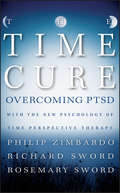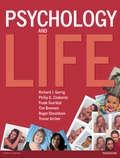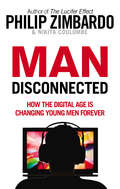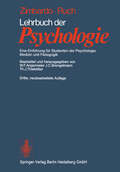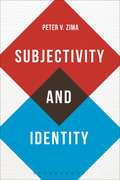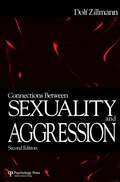- Table View
- List View
The Time Cure: Overcoming PTSD with the New Psychology of Time Perspective Therapy
by Philip Zimbardo Richard Sword Rosemary SwordIn his landmark book, The Time Paradox, internationally known psychologist Philip Zimbardo showed that we can transform the way we think about our past, present, and future to attain greater success in work and in life. Now, in The Time Cure, Zimbardo has teamed with clinicians Richard and Rosemary Sword to reveal a groundbreaking approach that helps those living with post-traumatic stress disorder (PTSD) to shift their time perspectives and move beyond the traumatic past toward a more positive future. Time Perspective Therapy switches the focus from past to present, from negative to positive, clearing the pathway for the best yet to come: the future. It helps PTSD sufferers pull their feet out of the quicksand of past traumas and step firmly on the solid ground of the present, allowing them to take a step forward into a brighter future. Rather than viewing PTSD as a mental illness the authors see it as a mental injury—a normal reaction to traumatic events—and offer those suffering from PTSD the healing balm of hope. The Time Cure lays out the step-by-step process of Time Perspective Therapy, which has proven effective for a wide range of individuals, from veterans to survivors of abuse, accidents, assault, and neglect. Rooted in psychological research, the book also includes a wealth of vivid and inspiring stories from real-life PTSD sufferers—effective for individuals seeking self-help, their loved ones, therapists and counselors, or anyone who wants to move forward to a brighter future.
Psychology and Life (PDF)
by Philip Zimbardo Richard J. Gerrig Prof Frode Svartdal Prof Tim Brennen Roger Donaldson Prof Trevor ArcherPsychology and Life introduces students to the core areas of psychology by showing them just how relevant these topics are to their day to day lives. Bringing Gerrig and Zimbardo’s classic textbook, now in its 19th edition, to a European audience, this exciting new adaptation for students of introductory psychology offers a greater focus on current European research while retaining the same rigorous, scientific approach and enthusiasm for applying psychology to daily life that has made it so popular with students.
Psychologie: Die Entwicklung ihrer Grundannahmen seit der Einführung des Experiments (Wissenschaftliche Forschungsberichte)
by Philip G. Zimbardo Wolfgang MetzgerPsychologie (Springer-Lehrbuch)
by Philip G. ZimbardoDer ZIMBARDO ist bekannt als das Einstiegsbuch in die Psychologie schlechthin! Anschaulich und verständlich geschrieben, gibt dieses erfolgreiche Lehrbuch einen umfassenden Überblick über die gesamte Psychologie. Auch die sechste Auflage zeichnet sich durch inhaltliche Aktualität und Breite aus. Doch gegenüber früheren Auflagen ist die sechste Auflage didaktisch völlig neu gestaltet: - ein freundliches, modernes Layout - klar strukturiert und gegliedert, - Lernhilfen und - die optische Betonung von Merksätzen, zentralen Begriffen und klassischen Experimenten der Psychologie erleichtern die Lektüre und machen den ZIMBARDO zum konkurrenzlosen Einsteigerbuch für jeden, der die Wissenschaft Psychologie kennenlernen möchte.
Man Disconnected: How technology has sabotaged what it means to be male
by Philip Zimbardo Nikita D. Coulombe'Zimbardo has put his finger on a great challenge of the modern era' - The Sunday TimesMasculinity is in meltdown. Young men are failing as never before — academically, socially and sexually. But why? And what needs to be done?Internationally-acclaimed psychologist Philip Zimbardo, and research partner Nikita Coulombe, show how symptoms include excessive gaming and porn use, apathy and drug abuse. They argue that digital technologies create alternative worlds that many boys find less demanding and more rewarding than real life, yet which are ultimately harmful.There is hope. Man Disconnected reveals where the solutions are to be found, and what action we can take. Controversial, provocative and insightful, this book is an alarm call ignored at our peril.
The Lucifer Effect: How Good People Turn Evil
by Philip ZimbardoIn The Lucifer Effect, the award-winning and internationally respected psychologist, Philip Zimbardo, examines how the human mind has the capacity to be infinitely caring or selfish, kind or cruel, creative or destructive. He challenges our conceptions of who we think we are, what we believe we will never do - and how and why almost any of us could be initiated into the ranks of evil doers.At the same time he describes the safeguards we can put in place to prevent ourselves from corrupting - or being corrupted by - others, and what sets some people apart as heroes and heroines, able to resist powerful pressures to go along with the group, and to refuse to be team players when personal integrity is at stake.Using the first in-depth analysis of his classic Stanford Prison Experiment, and his personal experiences as an expert witness for one of the Abu Ghraib prison guards, Zimbardo's stimulating and provocative book raises fundamental questions about the nature of good and evil, and how each one of us needs to be vigilant to prevent becoming trapped in the 'Lucifer Effect', no matter what kind of character or morality we believe ourselves to have.The Lucifer Effect won the William James Book Award in 2008.
Lehrbuch der Psychologie: Eine Einführung für Studenten der Psychologie, Medizin und Pädagogik
by P.G. ZimbardoDas "Lehrbuch der Psychologie", das hier in 3. Auflage vorliegt, bringt einen knappen, aber umfassenden Überblick über das Gesamtgebiet der Psychologie. Durch Hinweise auf zahlreiche experimentelle Studien versucht das Buch die wissenschaftlichen Erkenntnisse der modernen Psychologie klar zu umreißen, obgleich auch die spekulativen Elemente nicht zu kurz kommen. Die Darstellungen in diesem Buch setzen sich kritisch mit den individuellen und kollektiven Problemen unserer modernen Welt auseinander, ohne diese verschönern oder zerstreuen zu wollen. Besonders wichtige Studien und Erkenntnisse werden" Unter die Lupe" genommen und eingehend analysiert. Die didaktischen Vorzüge der Originalausgabe wurden auch in dem hier vorliegenden Buch voll und ganz zur Geltung gebracht. Das Buch wendet sich an einen Leserkreis ohne besondere Vorkenntnisse, obgleich Sinn und Verständnis für wissenschaftliche Methoden voraus gesetzt werden. Besonders wertvoll ist dieses Werk für die Anfangsse mester der Psychologie und Soziologie, da kein vergleichbares Werk in deutscher Sprache vorliegt. Dies gilt auch für die Medizinstudente- im Hinblick auf die Anforderungen der neuen Approbationsordnung für Ärzte - und für die Studenten der Pädagogik, denen das vorliegende Buch auch für ihr Fachgebiet Grundlage sein soll. Im Gegensatz zu den früheren Auflagen dieses Lehrbuches erscheint hier ein zusätzliches Kapitel über die Pervertierung des menschlichen Potentials, welches im Hinblick auf die Entwicklung des Terrorismus von besonderem Interesse sein dürfte. Es soll darauf hingewiesen werden, daß die Meinung der Autoren nicht notwendigerweise mit der der Übersetzer übereinzustimmen braucht. Die Übersetzung ist in Zusammenarbeit mit Studenten der Psychologie entstanden, deren Sprache dieses Buch ja sprechen soll.
Psychologie
by P.G. ZimbardoPsychologische Forschung versucht die Struktur Psychologie ist Wissenschaft vom Verhalten. des Verhaltens aufzuzeichnen, Ursachen von Psychologie ist die Frage nach dem, was den Reaktionen zu finden und Sinn und Ordnung Menschen bewegt. dort zu sehen, wo oft Zufälltigkeit und Chaos zu Psychologie befaßt sich mit dem menschlichen herrschen scheinen. Da die Psychologie ein Be Geist. standteil des täglichen Lebens ist, werden wir Psychologie befaßt sich mit der Frage, wie Lebe versuchen zu zeigen, wie die Methoden der wesen mit ihrer Umwelt und miteinander fertig psychologischen Forschung und deren Ergeb werden. In der Psychologie begegnen sich die nisse oft Aussagen ermöglichen, die für jeden Philosophie, die Biologie, die Soziologie, die von uns interessant und von Bedeutung sind. Physiologie und die Anthropologie. Bei der Untersuchung psychischer Prozesse gibt Psychologie ist das, was den Menschen von einer es gewöhnlich 3 grundsätzliche Probleme zu Maschine unterscheidet. berücksichtigen: Wie stellt man die richtigen Psychologie ist eine Art Wissen und Vorgehen, Fragen, wie findet man die richtigen Antworten welches benutzt werden kann, um die Qualität und wie bewertet man deren Gültigkeit? Dem menschlichen Lebens zu verbessern. entsprechend befassen sich die ersten Kapitel Psychologie ist all das - und vielleicht noch dieses Buches mit der Erforschung von Verhal mehr. tensphänomenen auf unterschiedlichen Ebe Es ist heute nahezu unmöglich, eine Zeitung zu nen, mit Methoden der wissenschaftlichen Fra lesen, ohne auf irgendwelche psychologischen gestellung und mit Möglichkeiten, falsche Aus Phänomene wie z.B. Drogenmißbrauch, Ge sagen einzugrenzen.
Subjectivity and Identity: Between Modernity and Postmodernity (Bloomsbury Studies in Philosophy)
by Peter V. ZimaSubjectivity and Identity is a philosophical and interdisciplinary study that critically evaluates critically the most important philosophical, sociological, psychological and literary debates on subjectivity and the subject. Starting from a history of the concept of the subject from modernity to postmodernity - from Descartes and Kant to Adorno and Lyotard - Peter V. Zima distinguishes between individual, collective, mythical and other subjects.Most texts on subjectivity and the subject present the topic from the point of view of a single discipline: philosophy, sociology, psychology or theory of literature. In Subjectivity and Identity Zima links philosophical approaches to those of sociology, psychology and literary criticism. The link between philosophy and sociology is social philosophy (e.g. Althusser, Marcuse, Habermas), the link between philosophy and literary criticism is aesthetics (e.g. Adorno, Lyotard, Vattimo). Philosophy and psychology can be related thanks to the psychological implications of several philosophical concepts of subjectivity (Hobbes, Stirner, Sartre).
Subjectivity and Identity: Between Modernity and Postmodernity (Bloomsbury Studies in Philosophy)
by Peter V. ZimaSubjectivity and Identity is a philosophical and interdisciplinary study that critically evaluates critically the most important philosophical, sociological, psychological and literary debates on subjectivity and the subject. Starting from a history of the concept of the subject from modernity to postmodernity - from Descartes and Kant to Adorno and Lyotard - Peter V. Zima distinguishes between individual, collective, mythical and other subjects.Most texts on subjectivity and the subject present the topic from the point of view of a single discipline: philosophy, sociology, psychology or theory of literature. In Subjectivity and Identity Zima links philosophical approaches to those of sociology, psychology and literary criticism. The link between philosophy and sociology is social philosophy (e.g. Althusser, Marcuse, Habermas), the link between philosophy and literary criticism is aesthetics (e.g. Adorno, Lyotard, Vattimo). Philosophy and psychology can be related thanks to the psychological implications of several philosophical concepts of subjectivity (Hobbes, Stirner, Sartre).
The Quest for the Nazi Personality: A Psychological Investigation of Nazi War Criminals
by Eric A. Zillmer Molly Harrower Barry A. Ritzler Robert P. ArcherHalf a century after the collapse of the Nazi regime and the Third Reich, scholars from a range of fields continue to examine the causes of Nazi Germany. An increasing number of young Americans are attempting to understand the circumstances that led to the rise of the Nazi party and the subsequent Holocaust, as well as the implication such events may have for today as the world faces a resurgence of neo-Nazism, ethnic warfare, and genocide. In the months following World War II, extensive psychiatric and psychological testing was performed on over 200 Nazis in an effort to understand the key personalities of the Third Reich and of those individuals who "just followed orders." In addressing these issues, the current volume examines the strange history of over 200 Rorschach Inkblot protocols that were administered to Nazi war criminals and answers such questions as: * Why the long delay in publishing protocols? * What caused such jealousies among the principals? * How should the protocols be interpreted? * Were the Nazis monsters or ordinary human beings? This text delivers a definitive and comprehensive study of the psychological functioning of Nazi war criminals -- both the elite and the rank-and-file. In order to apply a fresh perspective to understanding the causes that created such antisocial behavior, these analyses lead to a discussion within the context of previous work done in social and clinical psychology. Subjects discussed include the authoritarian personality, altruism, obedience to authority, diffusion of responsibility, and moral indifference. The implications for current political events are also examined as Neo-Nazism, anti-Semitism, and ethnic hate are once again on the rise. While the book does contain some technical material relating to the psychological interpretations, it is intended to be a scholarly presentation written in a narrative style. No prior knowledge of psychological testing is necessary, but it should be of great benefit for those interested in the Rorschach Inkblot test, or with a special interest in psychological testing, personality assessment, and the history of psychology. It is also intended for readers with a broad interest in Nazi Germany.
The Quest for the Nazi Personality: A Psychological Investigation of Nazi War Criminals
by Eric A. Zillmer Molly Harrower Barry A. Ritzler Robert P. ArcherHalf a century after the collapse of the Nazi regime and the Third Reich, scholars from a range of fields continue to examine the causes of Nazi Germany. An increasing number of young Americans are attempting to understand the circumstances that led to the rise of the Nazi party and the subsequent Holocaust, as well as the implication such events may have for today as the world faces a resurgence of neo-Nazism, ethnic warfare, and genocide. In the months following World War II, extensive psychiatric and psychological testing was performed on over 200 Nazis in an effort to understand the key personalities of the Third Reich and of those individuals who "just followed orders." In addressing these issues, the current volume examines the strange history of over 200 Rorschach Inkblot protocols that were administered to Nazi war criminals and answers such questions as: * Why the long delay in publishing protocols? * What caused such jealousies among the principals? * How should the protocols be interpreted? * Were the Nazis monsters or ordinary human beings? This text delivers a definitive and comprehensive study of the psychological functioning of Nazi war criminals -- both the elite and the rank-and-file. In order to apply a fresh perspective to understanding the causes that created such antisocial behavior, these analyses lead to a discussion within the context of previous work done in social and clinical psychology. Subjects discussed include the authoritarian personality, altruism, obedience to authority, diffusion of responsibility, and moral indifference. The implications for current political events are also examined as Neo-Nazism, anti-Semitism, and ethnic hate are once again on the rise. While the book does contain some technical material relating to the psychological interpretations, it is intended to be a scholarly presentation written in a narrative style. No prior knowledge of psychological testing is necessary, but it should be of great benefit for those interested in the Rorschach Inkblot test, or with a special interest in psychological testing, personality assessment, and the history of psychology. It is also intended for readers with a broad interest in Nazi Germany.
Sports Medicine and Neuropsychology: the Neuropsychologist's Role in the Assessment and Management of Sports-related Concussions:a Special Issue of applied Neuropsychology
by Eric A. ZillmerThe focus of Sports Medicine and Neuropsychology is the question of what role the neuropsychologist should have in the diagnosis, treatment, and management of sports-related concussions. The goal of this special issue is to examine the most current issues facing this growing and dynamic field of neuropsychology. The first article is dedicated to reviewing current issues in the neuropsychological assessment of concussions in sports-related events. The next paper examines data on over six million practice-and-game-exposures among athletes participating in the NCAA's Injury Surveillance System. Two contributions examine the empirical role that neuropsychologists can have in the area of concussion research. The final two papers review the advantages and limitations on computer-based assessment of sports-related concussions and discuss neuropsychology's role in return-to-play decisions following them.
Connections Between Sexuality and Aggression
by Dolf ZillmannThis is the only available comprehensive monograph on interrelations and interdependencies between agonistic and sexual behaviors. Integrating theory and research from biology, anthropology, neurophysiology, endocrinology, psychophysiology, and psychology, this book focuses on the mechanisms that govern the mutual influences between sexuality and aggression in behavior sequences and especially in admixtures of aggressive-sexual behaviors. This book places human agonistic and sexual behaviors into an evolutionary context. It offers a Weltbild of human aggressive-sexual behaviors by tracing their biological and developmental origins and examines the plasticity and manipulability of connections between agonistic and sexual behaviors. Strategies for the maximization of sexual pleasures are elaborated , and intervention treatments--aiming at the control of violent behaviors--are considered. Coercive sexuality is given special attention. Prevalent motive ascriptions to rape are called into question and the motivation that dominates rape is reinterpreted in the context of pleasure maximization. This second edition brings the coverage of pertinent research up to date. It advances the exploration of aggressive-sexual behaviors by further integrating the research contributions from various disciplines, and by refining and unifying theory capable of explaining the behavioral phenomena under consideration. COPY FOR ZILLMANN MAILER Zillmann examines issues such as sexual access through aggression, the involvement of agonistic behavior within sexuality, sex-aggression fusion, the consequences of anticipatory imagination concerning sexuality, and aspects of libido loss due to excitatory habituation. This book also: * traces connection between sexuality and aggression in nonhuman species, especially in nonhuman primates, * subjects human behavior to comparative and evolutionary analysis, * examines connectedness in neurological and endocrinological terms, * details both central and autonomic commonalities between sexual and aggressive behaviors, * outlines sexual dimorphism and chromosomal-endocrine aberrations, * pays special attention to adrenal commonalities in sexual and aggressive behaviors and the fusion of these behaviors, and * examines aggressive-sexual connectedness in the analysis of motivation and emotion. Zillmann finally proposes new explanations for the numerous documented associations between sexuality and aggression. These proposals combine biological, neuroendocrine, autonomic, and cognitive aspects of aggressive and sexual behaviors. A trichotomy of excitatory interdependencies is developed for fight, flight, and coition. In the nomenclature of emotion, this trichotomy concerns the interdependencies between aggressiveness, fear, and sexual impulsion. A considerable amount of research evidence is aggregated in support of these interdependencies. The author ultimately examines the exploitation of the existing connections between sexual and aggressive behaviors, especially the exploitation that serves the enhancement of sexual pleasure. In this context he arrives at novel, and perhaps distressing, characterizations of sexual coercion. However, he also explores sexual boredom and discusses remedies in the framework of his theorizing. Last but not least, sexual aggression, and sexual and aggressive behaviors independently, are placed into an evolutionary context. Recognition and acknowledgment of the archaic nature of many aspects of sexual and aggressive behaviors, in contrast to the comparatively vernal development of behavior-guiding contemplation, leads him to a unique and provocative proposal of the function of aggression in the realm of sexuality.
Connections Between Sexuality and Aggression
by Dolf ZillmannThis is the only available comprehensive monograph on interrelations and interdependencies between agonistic and sexual behaviors. Integrating theory and research from biology, anthropology, neurophysiology, endocrinology, psychophysiology, and psychology, this book focuses on the mechanisms that govern the mutual influences between sexuality and aggression in behavior sequences and especially in admixtures of aggressive-sexual behaviors. This book places human agonistic and sexual behaviors into an evolutionary context. It offers a Weltbild of human aggressive-sexual behaviors by tracing their biological and developmental origins and examines the plasticity and manipulability of connections between agonistic and sexual behaviors. Strategies for the maximization of sexual pleasures are elaborated , and intervention treatments--aiming at the control of violent behaviors--are considered. Coercive sexuality is given special attention. Prevalent motive ascriptions to rape are called into question and the motivation that dominates rape is reinterpreted in the context of pleasure maximization. This second edition brings the coverage of pertinent research up to date. It advances the exploration of aggressive-sexual behaviors by further integrating the research contributions from various disciplines, and by refining and unifying theory capable of explaining the behavioral phenomena under consideration. COPY FOR ZILLMANN MAILER Zillmann examines issues such as sexual access through aggression, the involvement of agonistic behavior within sexuality, sex-aggression fusion, the consequences of anticipatory imagination concerning sexuality, and aspects of libido loss due to excitatory habituation. This book also: * traces connection between sexuality and aggression in nonhuman species, especially in nonhuman primates, * subjects human behavior to comparative and evolutionary analysis, * examines connectedness in neurological and endocrinological terms, * details both central and autonomic commonalities between sexual and aggressive behaviors, * outlines sexual dimorphism and chromosomal-endocrine aberrations, * pays special attention to adrenal commonalities in sexual and aggressive behaviors and the fusion of these behaviors, and * examines aggressive-sexual connectedness in the analysis of motivation and emotion. Zillmann finally proposes new explanations for the numerous documented associations between sexuality and aggression. These proposals combine biological, neuroendocrine, autonomic, and cognitive aspects of aggressive and sexual behaviors. A trichotomy of excitatory interdependencies is developed for fight, flight, and coition. In the nomenclature of emotion, this trichotomy concerns the interdependencies between aggressiveness, fear, and sexual impulsion. A considerable amount of research evidence is aggregated in support of these interdependencies. The author ultimately examines the exploitation of the existing connections between sexual and aggressive behaviors, especially the exploitation that serves the enhancement of sexual pleasure. In this context he arrives at novel, and perhaps distressing, characterizations of sexual coercion. However, he also explores sexual boredom and discusses remedies in the framework of his theorizing. Last but not least, sexual aggression, and sexual and aggressive behaviors independently, are placed into an evolutionary context. Recognition and acknowledgment of the archaic nature of many aspects of sexual and aggressive behaviors, in contrast to the comparatively vernal development of behavior-guiding contemplation, leads him to a unique and provocative proposal of the function of aggression in the realm of sexuality.
The Life of Gregory Zilboorg, 1890–1940: Psyche, Psychiatry, and Psychoanalysis (The History of Psychoanalysis Series)
by Caroline ZilboorgThe Life of Gregory Zilboorg, 1890–1940: Psyche, Psychiatry, and Psychoanalysis is the first volume of a meticulously researched two-part biography of the Russian-American psychoanalyst Gregory Zilboorg and chronicles the period from his birth as a Jew in Tsarist Russia to his prominence as a New York psychoanalyst on the eve of the Second World War. Educated in Kiev and Saint Petersburg, Zilboorg served as a young physician during the First World War and, after the revolution, as secretary to the minister of labour in Kerensky’s provisional government. Having escaped following Lenin’s takeover, Zilboorg requalified in medicine at Columbia University and underwent analysis with Franz Alexander at the Berlin Psychoanalytic Institute. His American patients ranged from wealthy and artistic figures such as George Gershwin and Lillian Hellman to prison inmates. His writing includes important histories of psychiatry, for which he is still known, as well as examinations of gender, suicide, and the relationship between psychiatry and the law. His socialist politics and late work on Freud’s (mis)understanding of religious belief created a wide circle of friends and acquaintances, from members of the Warburg banking family to the Trappist monk Thomas Merton. Drawing on previously unpublished sources, including family papers and archival material, The Life of Gregory Zilboorg, 1890–1940: Psyche, Psychiatry, and Psychoanalysis offers a dramatic narrative that will appeal to general readers as well as scholars interested in the First World War, the Russian revolution, the Jewish diaspora, and the history of psychoanalysis.
The Life of Gregory Zilboorg, 1890–1940: Psyche, Psychiatry, and Psychoanalysis (The History of Psychoanalysis Series)
by Caroline ZilboorgThe Life of Gregory Zilboorg, 1890–1940: Psyche, Psychiatry, and Psychoanalysis is the first volume of a meticulously researched two-part biography of the Russian-American psychoanalyst Gregory Zilboorg and chronicles the period from his birth as a Jew in Tsarist Russia to his prominence as a New York psychoanalyst on the eve of the Second World War. Educated in Kiev and Saint Petersburg, Zilboorg served as a young physician during the First World War and, after the revolution, as secretary to the minister of labour in Kerensky’s provisional government. Having escaped following Lenin’s takeover, Zilboorg requalified in medicine at Columbia University and underwent analysis with Franz Alexander at the Berlin Psychoanalytic Institute. His American patients ranged from wealthy and artistic figures such as George Gershwin and Lillian Hellman to prison inmates. His writing includes important histories of psychiatry, for which he is still known, as well as examinations of gender, suicide, and the relationship between psychiatry and the law. His socialist politics and late work on Freud’s (mis)understanding of religious belief created a wide circle of friends and acquaintances, from members of the Warburg banking family to the Trappist monk Thomas Merton. Drawing on previously unpublished sources, including family papers and archival material, The Life of Gregory Zilboorg, 1890–1940: Psyche, Psychiatry, and Psychoanalysis offers a dramatic narrative that will appeal to general readers as well as scholars interested in the First World War, the Russian revolution, the Jewish diaspora, and the history of psychoanalysis.
The Life of Gregory Zilboorg, 1940–1959: Mind, Medicine, and Man (The History of Psychoanalysis Series)
by Caroline ZilboorgThe Life of Gregory Zilboorg, 1940–1959: Mind, Medicine, and Man is the second volume of a meticulously researched two-part biography of the Russian-American psychoanalyst Gregory Zilboorg and chronicles the impact of the Second World War on his work and thinking as well as his divorce, remarriage, and conversion to Catholicism. With extensive references to Zilboorg’s writing and politics, this book demonstrates the significance of his contributions to the fields of psychiatry and psychoanalysis in the context of his tumultuous intellectual, personal, and spiritual life. In his late work, he would argue, controversially, that there was no incompatibility between psychoanalysis and religion. Grounded in a wealth of primary source material and impressive research, this book completes the compelling biography of a major figure in psychoanalysis. It will be of interest to general readers as well as scholars across a range of disciplines, particularly the history of psychoanalysis and religion.
The Life of Gregory Zilboorg, 1940–1959: Mind, Medicine, and Man (The History of Psychoanalysis Series)
by Caroline ZilboorgThe Life of Gregory Zilboorg, 1940–1959: Mind, Medicine, and Man is the second volume of a meticulously researched two-part biography of the Russian-American psychoanalyst Gregory Zilboorg and chronicles the impact of the Second World War on his work and thinking as well as his divorce, remarriage, and conversion to Catholicism. With extensive references to Zilboorg’s writing and politics, this book demonstrates the significance of his contributions to the fields of psychiatry and psychoanalysis in the context of his tumultuous intellectual, personal, and spiritual life. In his late work, he would argue, controversially, that there was no incompatibility between psychoanalysis and religion. Grounded in a wealth of primary source material and impressive research, this book completes the compelling biography of a major figure in psychoanalysis. It will be of interest to general readers as well as scholars across a range of disciplines, particularly the history of psychoanalysis and religion.
Children in Family Therapy: Treatment and Training
by Joan J ZilbachHere is one of the few books that focuses explicitly on including children in family therapy sessions. The contributors to this enlightening volume are seasoned family therapists of various theoretical perspectives who work in a variety of settings and include children of all ages in their therapy practices. Recognizing that many practicing therapists are not comfortable including children, they address the treatment and training issues and provide extensive case studies and fascinating background material on their own early involvement in the practice. Children in Family Therapy will be extremely valuable to family therapists of all levels of experience. For the veterans, the cases that are different in approach from their own will be particularly informative. Less experienced therapists will find here a basic introduction and a clear description of the range of clinical practice in family therapy.
Children in Family Therapy: Treatment and Training
by Joan J ZilbachHere is one of the few books that focuses explicitly on including children in family therapy sessions. The contributors to this enlightening volume are seasoned family therapists of various theoretical perspectives who work in a variety of settings and include children of all ages in their therapy practices. Recognizing that many practicing therapists are not comfortable including children, they address the treatment and training issues and provide extensive case studies and fascinating background material on their own early involvement in the practice. Children in Family Therapy will be extremely valuable to family therapists of all levels of experience. For the veterans, the cases that are different in approach from their own will be particularly informative. Less experienced therapists will find here a basic introduction and a clear description of the range of clinical practice in family therapy.
Sehstörungen bei Kindern: Visuoperzeptive und visuokognitive Störungen bei Kindern mit CVI
by Josef Zihl Katharina Mendius Susanne Schuett Siegfried PriglingerIn dem Buch werden zerebrale Sehstörungen bei Kindern und deren Diagnose erörtert sowie therapeutische Optionen vorgestellt. Klar verständlich skizzieren die Autoren die Organisation und Funktionsweise des Zentralnervensystems, die Entwicklung der verschiedenen Teilleistungen, ihre Störungen sowie Diagnostik und Dokumentation. Ausführliche Handlungsanweisungen sowie anschauliche Fallbeispiele schlagen die Brücke in die Praxis. Die überarbeitete und aktualisierte 2. Auflage wurde um neue Konzepte wie CVI (Cerebral Visual Impairment) ergänzt.
Cerebral Visual Impairment in Children: Visuoperceptive and Visuocognitive Disorders
by Josef Zihl Gordon N. DuttonCerebral visual disorders have far-reaching consequences for child development. These have profound adverse effects on children’s education and success in school and also in later life, but, unfortunately, cerebral visual disorders often remain undiagnosed and untreated in the pediatric population. This book provides a state-of-the-art account of what is known about the development and disorders of visual perception in children. It covers the development and disorders of visual perception in children, their assessment, early intervention and management in an interdisciplinary context, both from a scientific as well as clinical perspective. Case studies illustrate the recommended assessment and rehabilitation procedures; synopses, boxes and check-lists complement the presentation of our recommendations for clinical practice.
Cerebral Visual Disorders In Children: Visuoperceptive And Visuocognitive Disorders (PDF)
by Josef Zihl Gordon DuttonCerebral visual disorders have far-reaching consequences for child development. These have profound adverse effects on children's education and success in school and also in later life, but, unfortunately, cerebral visual disorders often remain undiagnosed and untreated in the pediatric population. This book provides a state-of-the-art account of what is known about the development and disorders of visual perception in children. It covers the development and disorders of visual perception in children, their assessment, early intervention and management in an interdisciplinary context, both from a scientific as well as clinical perspective. Case studies illustrate the recommended assessment and rehabilitation procedures; synopses, boxes and check-lists complement the presentation of our recommendations for clinical practice.
Rehabilitation of Visual Disorders After Brain Injury
by Josef ZihlDespite a long research tradition in visual neuroscience, the rehabilitation of cerebral visual deficits has, until recently, been neglected. This book is the first to report systematic observations on spontaneous recovery of cerebral visual deficits after acquired brain injury, and the outcome of treating these deficits. The whole range of human visual functions and capacities is covered: visual field, visual acuity and contrast sensitivity, visual adaptation, colour vision, visual space perception, and visual cognition. Additionally, there is a special section devoted to patients with central scotoma. All treatment procedures described are empirically founded.
